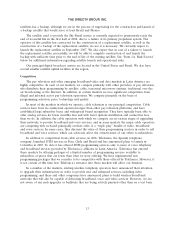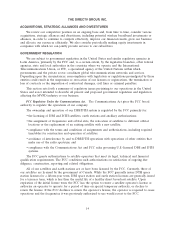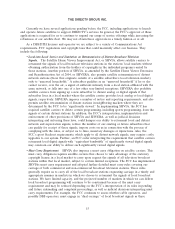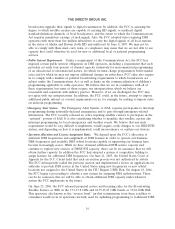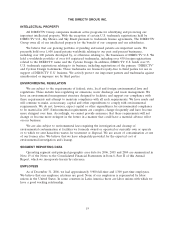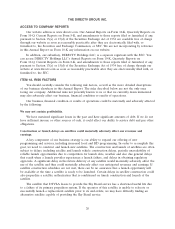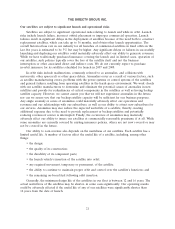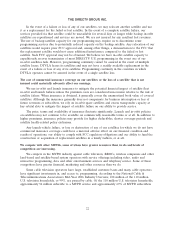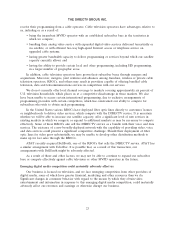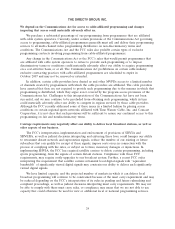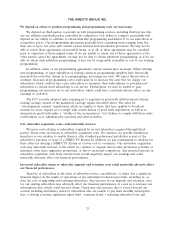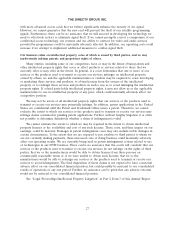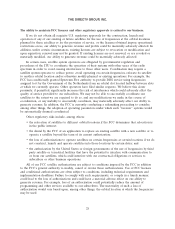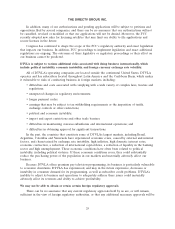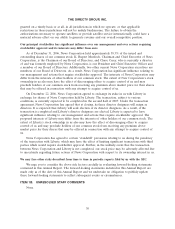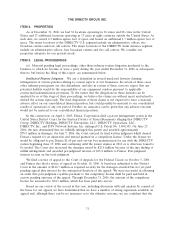DIRECTV 2006 Annual Report Download - page 34
Download and view the complete annual report
Please find page 34 of the 2006 DIRECTV annual report below. You can navigate through the pages in the report by either clicking on the pages listed below, or by using the keyword search tool below to find specific information within the annual report.THE DIRECTV GROUP, INC.
receive their programming from a cable operator. Cable television operators have advantages relative to
us, including or as a result of:
• being the incumbent MVPD operator with an established subscriber base in the territories in
which we compete;
• bundling their analog video service with expanded digital video services delivered terrestrially or
via satellite, or with efficient two-way high-speed Internet access or telephone service on
upgraded cable systems;
• having greater bandwidth capacity to deliver programming or services beyond which our satellite
capacity currently allows; and
• having the ability to provide certain local and other programming, including HD programming,
in a larger number of geographic areas.
In addition, cable television operators have grown their subscriber bases through mergers and
acquisitions. Moreover, mergers, joint ventures and alliances among franchise, wireless or private cable
television operators, RBOCs, and others may result in providers capable of offering bundled cable
television, data and telecommunications services in competition with our services.
We do not currently offer local channel coverage to markets covering approximately six percent of
U.S. television households, which places us at a competitive disadvantage in those markets. We also
have been unable to secure certain international programming, due to exclusive arrangements of
programming providers with certain competitors, which has constrained our ability to compete for
subscribers who wish to obtain such programming.
In the United States various RBOCs have deployed fiber optic lines directly to customers’ homes
or neighborhoods to deliver video services, which compete with the DIRECTV service. It is uncertain
whether we will be able to increase our satellite capacity, offer a significant level of new services in
existing markets in which we compete or expand to additional markets as may be necessary to compete
effectively. Some of these RBOCs also sell the DIRECTV service as a bundle with their voice and data
services. The existence of a new broadly-deployed network with the capability of providing video, voice
and data services could present a significant competitive challenge. Should their deployment of fiber
optic lines for video grow substantially, we may be unable to develop other distribution methods to
make up for lost sales through the RBOCs.
AT&T recently acquired BellSouth, one of the RBOCs that sells the DIRECTV service. AT&T has
a similar arrangement with EchoStar. It is possible that, as a result of this transaction, our
arrangements with BellSouth might be adversely affected.
As a result of these and other factors, we may not be able to continue to expand our subscriber
base or compete effectively against cable television or other MVPD operators in the future.
Emerging digital media competition could materially adversely affect us.
Our business is focused on television, and we face emerging competition from other providers of
digital media, some of which have greater financial, marketing and other resources than we do.
Significant changes in consumer behavior with regard to the means by which they obtain video
entertainment and information in response to this emerging digital media competition, could materially
adversely affect our revenues and earnings or otherwise disrupt our business.
23


